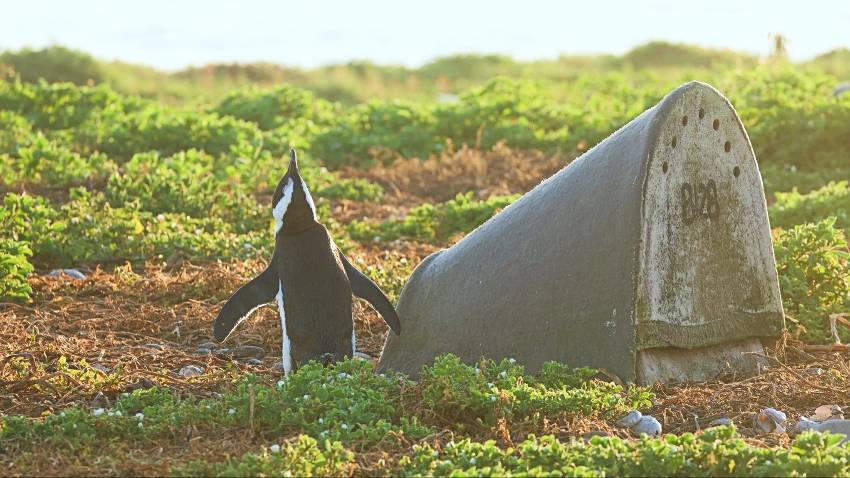African penguins, one of the world’s most endangered seabird species, are getting a helping hand from artificial nests. A new study reveals these man-made homes can significantly increase breeding success, but the most effective designs vary by colony location.
Summary: A 12-year study across South Africa shows artificial nests outperform natural ones for endangered African penguins, increasing breeding output by 16.5%. However, nest effectiveness varies by colony, highlighting the need for tailored conservation strategies.
Estimated reading time: 5 minutes
In a world where African penguin populations have plummeted by 90% over the past 70 years, conservation efforts are more crucial than ever. A recent study published in the British Ecological Society journal, Ecological Solutions and Evidence, offers a glimmer of hope for these endangered birds.
Artificial Nests: A Boost for Breeding
Researchers from South Africa and the UK conducted a comprehensive 12-year study across South Africa’s eight largest African penguin colonies. Their findings reveal that artificial nests can significantly improve breeding success, outperforming natural nests and increasing breeding output by an impressive 16.5%.
Professor Lorien Pichegru from Nelson Mandela University’s Institute for Coastal and Marine Research, who led the study, explained: “The most effective designs of artificial nests were colony-specific, with different colonies facing different threats. Penguins at land colonies such as Boulders Beach face threats from mammals, whereas penguins at colonies devoid of vegetation such as Bird Island face sun exposure. Different artificial nest designs were more suited to responding to different threats.”
This discovery highlights the importance of tailored conservation approaches for different penguin colonies. While the newly designed double-layered ceramic nests generally performed best, their effectiveness varied across locations.
Beyond Nests: Addressing Broader Threats
While artificial nests offer a promising conservation tool, they alone cannot reverse the African penguin’s decline. Professor Pichegru emphasized the need for more comprehensive measures: “The main causes of the recent decline in African penguin numbers are poor food availability, oil spills, underwater noise pollution and predation. Biologically meaningful fishing exclusion zones around their major colonies are urgently needed.”
The study underscores the complex challenges facing African penguins. With only about 8,500 breeding pairs remaining, these birds are teetering on the brink of extinction. Artificial nests address one aspect of their struggle – the lack of suitable nesting habitats – but a multi-faceted approach is essential for long-term survival.
The Science Behind the Nests
Researchers evaluated four types of artificial nests:
- Newly designed ceramic nests with slanted roofs and a 5cm air gap between layers
- A-framed pine plywood nests (the oldest design)
- Cement nests made of a mixture of fiberglass and cement
- Fiberglass burrows mimicking natural penguin burrows
The team monitored both artificial and natural nests weekly, tracking egg-laying through to chick fledging or nest failure. This meticulous approach allowed for a comprehensive comparison of nest effectiveness.
Dr. Richard Sherley, a co-author from the University of Exeter, noted some limitations of the study: “We weren’t always able to follow the fate of individual birds or breeding pairs closely over multiple years in this study. That means we can’t be certain how much of the benefit we measured comes from the ‘best’ penguins actively choosing to breed in artificial nests.”
Future Directions for Penguin Conservation
The study’s findings open new avenues for research and conservation efforts. Professor Pichegru suggested: “Understanding the mechanisms by which artificial nests improve breeding success at different colonies could help to improve future artificial nest designs. For instance, is it improved protection from predators, is it decrease heat loads on eggs or something else?”
As researchers continue to refine artificial nest designs and explore their impact, the hope is that these efforts will contribute to a brighter future for African penguins. However, it’s clear that nest improvements alone won’t be enough. Comprehensive conservation strategies addressing food availability, pollution, and habitat protection will be crucial in ensuring the survival of these charismatic seabirds.
Quiz: Test Your Knowledge on African Penguin Conservation
- By what percentage have African penguin populations declined in the last 70 years? a) 50% b) 70% c) 90% d) 95%
- What was the overall increase in breeding output for penguins using artificial nests? a) 5.5% b) 10.5% c) 16.5% d) 20.5%
- According to the study, which type of artificial nest was generally most effective? a) A-framed pine plywood nests b) Cement nests c) Fiberglass burrows d) Double-layered ceramic nests
Answers:
- c) 90%
- c) 16.5%
- d) Double-layered ceramic nests
Glossary of Terms
- Artificial nests: Man-made structures designed to provide suitable breeding habitats for birds.
- Breeding success: The rate at which breeding attempts result in successfully raised offspring.
- Colony: A group of birds of the same species living and breeding in close proximity.
- Conservation strategy: A plan of action designed to protect and preserve a species or habitat.
- Fledging: The stage at which a young bird is ready to leave the nest.
- Seabird: Birds that spend a significant portion of their lives at sea and typically breed on coastal areas or islands.
Enjoy this story? Get our newsletter! https://scienceblog.substack.com/
If our reporting has informed or inspired you, please consider making a donation. Every contribution, no matter the size, empowers us to continue delivering accurate, engaging, and trustworthy science and medical news. Independent journalism requires time, effort, and resources—your support ensures we can keep uncovering the stories that matter most to you.
Join us in making knowledge accessible and impactful. Thank you for standing with us!

